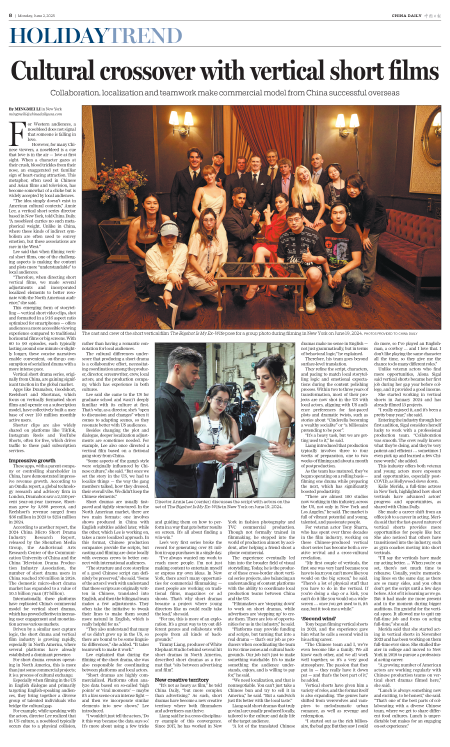
The cast and crew of the short vertical film The Bigshot Is My Ex-Wife pose for a group photo during filming in New York on June 19, 2024.

Director Annie Lee (center) discusses the script with actors on the set of The Bigshot Is My Ex-Wife in New York on June 19, 2024.
For Western audiences, a nosebleed does not signal that someone is falling in love.
However, for many Chinese viewers, a nosebleed is a cue that love is in the air — love at first sight. When a character gazes at their crush, blood trickles from their nose, an exaggerated yet familiar sign of heart-racing attraction. This metaphor, often used in Chinese and Asian films and television, has become somewhat of a cliche but is widely accepted by local audiences.
"The idea simply doesn't exist in American cultural contexts," Annie Lee, a vertical short series director based in New York, told China Daily. "A nosebleed carries no such metaphorical weight. Unlike in China, where these kinds of indirect symbolism are often used to convey emotion, but these associations are rare in the West."
Lee said that when filming vertical short films, one of the challenging aspects is making the content and plots more "understandable" to local audiences.
"Therefore, when directing short vertical films, we made several adjustments and incorporated localized elements to better resonate with the North American audience," she said.
This emerging form of storytelling — vertical short video clips, shot and formatted in a 9:16 aspect ratio optimized for smartphones — offers audiences a more accessible viewing experience compared to traditional horizontal films or big screens. With 60 to 90 episodes, each typically lasting around one minute or slightly longer, these concise narratives enable convenient, on-the-go consumption of serialized drama with a more intense pace.
Vertical short drama series, originally from China, are gaining significant traction in the global market.
Apps like Dramabox, Goodshort, Reelshort and Shortmax, which focus on vertically formatted short films and operate on a subscription model, have collectively built a user base of over 150 million monthly active users.
Shorter clips are also widely shared on platforms like TikTok, Instagram Reels and YouTube Shorts, often for free, which drives traffic to these paid subscription services.
Impressive growth
These apps, with a parent company or controlling shareholder in China, have demonstrated impressive revenue growth. According to an Omdia report, a global technology research and advisory firm in London, Dramabox saw a 2,550 percent year-on-year increase, Shortmax grew by 3,888 percent, and Reelshort's revenue surged from $36 million in 2023 to $214 million in 2024.
According to another report, the 2024 China Micro Short Drama Industry Research Report, released by the Shenzhen Media Group, the Audiovisual Arts Research Center of the Communication University of China and the China Television Drama Production Industry Association, the number of short drama users in China reached 576 million in 2024. The domestic micro-short drama market has expanded to a value of 50.5 billion yuan ($7 billion).
Internationally, these platforms have replicated China's commercial model for vertical short dramas, which has proved effective in increasing user engagement and monetization across various markets.
Driven by a similar user capture logic, the short drama and vertical film industry is growing rapidly, especially in North America, where several platforms have already established a dominant presence.
For short drama creators operating in North America, this is more than just some commercial projects; it is a process of cultural exchange.
Especially when filming in the US in English dialogue and primarily targeting English-speaking audiences, they bring together a diverse group of talented individuals who bridge the cultural gap.
For example, while speaking with the actors, director Lee realized that in US culture, a nosebleed typically occurs due to a physical collision, rather than having a romantic connotation for local audiences.
The cultural differences underscore that producing a short drama is a collaborative effort, necessitating coordination among the producer, director, screenwriter, crew, local actors, and the production company, which has experience in both cultures.
Lee said she came to the US for graduate school and wasn't deeply familiar with its culture at first. That's why, as a director, she's "open to discussion and changes" when it comes to adapting scenes, so they resonate better with US audiences.
Besides changing the plot and dialogue, deeper localization adjustments are sometimes needed. For example, Lee also once directed a vertical film based on a fictional gang story from China.
"Some aspects of the gang's style were originally influenced by Chinese culture," she said. "But once we set the story in the US, we had to localize things — the way the gang members talked, how they dressed, their overall vibe. We didn't keep the Chinese elements."
Short dramas are usually fast-paced and tightly structured. In the North American market, there are two main formats: one involves shows produced in China with English subtitles added later, while the other, which Lee is working on, takes a more localized approach. In this format, Chinese production companies provide the scripts, but casting and filming are done locally with overseas crews to better connect with international audiences.
"The structure and core storyline of a good Chinese script can definitely be preserved," she said. "Some of the actors I work with understand that these scripts are originally written in Chinese, translated into English, and then the bilingual team makes a few adjustments. They often take the initiative to tweak their lines to make them sound more natural in English, which is really helpful for us."
"They also understand that many of us didn't grow up in the US, so there are bound to be some linguistic differences," she added. "It takes teamwork to make it work."
Lee explained that during the filming of the short drama, she was also responsible for coordinating between platforms and local actors.
"Short dramas are highly commercialized. Platforms often analyze data based on so-called 'high points' or 'viral moments' — maybe it's a kiss scene or an intense fight — and then we incorporate similar elements into new shows," Lee introduced.
"I wouldn't just tell the actors, 'Do it this way because the data says so.' It's more about using a few tricks and guiding them on how to perform in a way that gets better results on screen. It's all about finding a win-win."
Lee's very first series broke the record for generating over $1 million in-app purchases in a single day.
"I've always wanted my work to reach more people. I'm not just making content to entertain myself or express my own ideas. In New York, there aren't many opportunities for commercial filmmaking — most people are working on traditional films, magazines or ad shoots. That's why short dramas became a project where young directors like us could really take the lead," she said.
"For me, this is more of an exploration. It's a great way to try out different genres and collaborate with people from all kinds of backgrounds."
Timmy Liang, producer of White Elephant Studio behind several hit short dramas in North America, described short dramas as a format that "sits between advertising and film".
New creative territory
"It's not as heavy as film," he told China Daily, "but more complex than advertising." As such, short dramas have become a new creative territory where both filmmakers and advertisers can thrive.
Liang said he is a cross-disciplinary example of this convergence. Since 2017, he has worked in New York in fashion photography and TVC commercial production. Though not formally trained in filmmaking, he stepped into the world of production almost by accident, after helping a friend shoot a phone commercial.
The experience eventually led him into the broader field of visual storytelling. Today, he is the producer of these cross-border short vertical series projects, also balancing an understanding of content platforms with the ability to coordinate local production teams between China and the US.
"Filmmakers are 'stepping down' to work on short dramas, while advertisers are 'stepping up' to create them. There are lots of opportunities for us in the industry," he said.
"Platforms may provide funding and scripts, but turning that into a real drama — that's our job as producers when coordinating the team in two time zones and cultural backgrounds. Our job isn't just to make something watchable. It's to make something the audience understands, enjoys, and is willing to pay for," he said.
"We need localization, and that is nonnegotiable. You can't just take a Chinese bun and try to sell it in America," he said. "But a sandwich just fits better with the local taste."
Liang said short dramas that truly go viral are usually produced locally, tailored to the culture and daily life of the target audience.
"A lot of the translated Chinese dramas make no sense in English — not just grammatically, but in terms of behavioral logic," he explained.
Therefore, his team goes beyond surface-level translation.
They refine the script, characters, and pacing to match local storytelling logic and emotional expectations during the content polishing process. Within two to three years of transformation, most of their projects are now shot in the US with local actors, aligning with US audience preferences for fast-paced plots and dramatic twists, such as stories about "Cinderella becoming a wealthy socialite" or "a billionaire pretending to be poor".
"It's a heavy task, but we are getting used to it," he said.
Liang introduced that production typically involves three to four weeks of preparation, one to two weeks of filming and about a month of postproduction.
As the team has matured, they've begun operating on a rolling basis — filming one drama while preparing the next, which has significantly boosted productivity.
"There are almost 100 studios now working in this industry, across the US, not only in New York and Los Angeles," he said. The market is full of vibrant potential and young, talented, and passionate people.
For veteran actor Tony Sharra, who has spent over three decades in the film industry, working on these Chinese-produced vertical short series has become both a creative revival and a cross-cultural revelation.
"My first couple of verticals, the first one was very hard because you have to learn you can't move like you would on the big screen," he said. "There's a lot of physical stuff that you have to do in the vertical. If you're doing a slap or a kick, you can't do it like you would on a widescreen … once you get used to it, it's easy, but it took me a while."
'Second wind'
Tony began filming vertical shorts in 2023, and the experience gave him what he calls a second wind in his acting career.
"The Chinese team and I, we've even become like a family. We all know each other, and we all work well together, so it's a very good atmosphere. The passion that they put in — they really have it down pat — and that's the best part of it," he added.
Vertical shorts have given him a variety of roles, and the format itself is also expanding. The genres have shifted from werewolves and vampires to melodramatic urban romance, as well as revenge and redemption.
"I started out as the rich billionaire, the bad guy. But they saw I could do more, so I've played an Englishman, a cowboy … and I love that. I don't like playing the same character all the time, so they give me the chance to do many different roles."
Unlike veteran actors who find more opportunities, Alona Sigal said vertical shorts became her first job during her gap year before college, and it provided a good income.
She started working in vertical shorts in January 2024 and has already filmed 13 projects.
"I really enjoyed it, and it's been a pretty busy year," she said.
Entering the industry through her first audition, Sigal considers herself lucky to work with a professional production team. "Collaboration was smooth. The crew really knows what they're doing, and they're very patient and efficient … sometimes I even pick up and learned a few Chinese words," she added.
This industry offers both veteran and young actors more exposure and opportunities, especially post-COVID, as Hollywood slows down.
Kalie Merida, a full-time actress in New York, highlighted how short verticals have advanced actors' progress and opportunities, as shared with China Daily.
She made a career shift from an office job to a career in acting. Merida said that the fast-paced nature of vertical shorts provides more opportunities for people like her. She also noticed that others have transitioned into the industry, such as gym coaches moving into short verticals.
"I'll say the verticals have made my acting better.… When you're on set, there's not much time to rehearse. Usually, you're memorizing lines on the same day, as there are so many sides, and you often don't get the script until a few days before. A lot of it is learning as we go. But it had made me more present and in the moment during bigger auditions. I'm grateful for the vertical space. It allowed me to quit my full-time job and focus on acting full-time," she said.
Merida said that she started acting in vertical shorts in November 2023 and has been working on them full-time ever since. She studied theater in college and moved to New York in 2018 to pursue a professional acting career.
"A growing number of American actors are working regularly with Chinese production teams on vertical short dramas filmed here," she said.
"Lunch is always something new and exciting, to be honest," she said. "That's one of the best parts of collaborating with a diverse Chinese team, where we get to share different food cultures. Lunch is unpredictable but makes for an engaging on-set experience."
mingmeili@chinadailyusa.com

